POT SHOP
CLAY COLLEGE POTTERS
11 & 12 NOVEMBER, 2023 11am -5pm Potters from left to right, starting top left:
Potters from left to right, starting top left:Alice Wakefield, Aliya Gunter, Isabelle Foreman, Callum Forbes, Camille Biddell, Eve Gnoyke, Grazyna Adrian, Hannah Sulek, Lucas George-Jones, Maya Hughes, Millie Brokenbrow, Rowena Hamilton, Will Keating, Jessica Mason (no longer showing), Zeba Imam (guest), Sarah Fraser (guest)
Alice Wakefield
I enjoy the soft qualities of making on a potter’s wheel, leaving on the finished pot a record of how it was made. I make functional pots hoping they act as a reminder to appreciate the littlest joys in each day, like drinking hot tea in the morning. I want my pots to feel inviting and warm. I embrace and sometimes encourage individualities in each pot. Mostly my inspiration for making comes from the physical nature of each process, for example how it feels to create a certain texture in the clay or the feeling of flow that comes from repeating a set of steps whilst throwing. I look to old objects too, though often not pots but maybe broken shards of pots or rusted metal objects.
I am also interested in the therapeutic nature of the craft and the accessibility clay has as a material. This has always played a role in my creative practise where I have run clay based workshops with other artists, exploring play, imagination, free expression and creating community.
Aliya Gunter
I find the exploration of art and design a concept which is a forever evolving journey, I feel that as people you can always grow and change, and I think that is also demonstrated through my work and the different themes I explore.
The forms I am interested in are often simplistic, but rely heavily on surface decoration and strategic mark-making, and this is often influenced by culture and heritage, but sometimes I enjoy just playing with the surface without necessarily having a sense of direction which I feel encourages the freeness in my work.
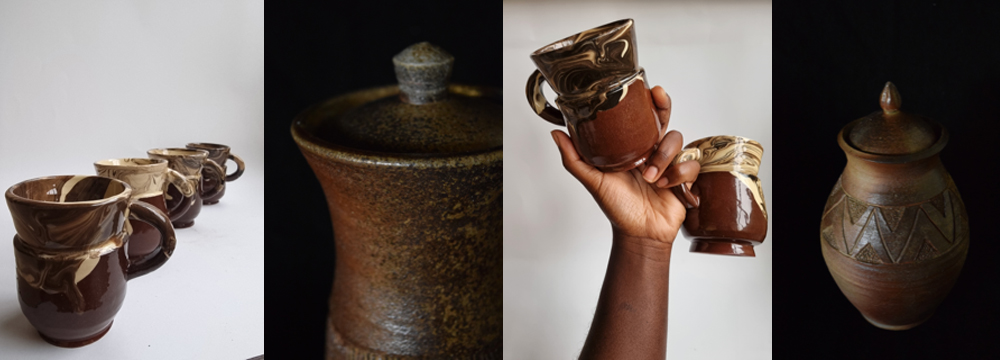 As we are encouraged to become more mindful about our contribution within the environment, I am researching practices which will enable me to move towards a more sustainable way of working and firing. I am hoping to delve deeper into pit and smoke firing, as using organic matter and bio-degradable materi
As we are encouraged to become more mindful about our contribution within the environment, I am researching practices which will enable me to move towards a more sustainable way of working and firing. I am hoping to delve deeper into pit and smoke firing, as using organic matter and bio-degradable materials is something I find interesting and is non-harmful, and I want to be exploring ways in which I can incorporate these methods into a process which will not only be better for the eco system, but also work harmoniously with my pieces.
Isabelle Foreman
Capturing the soft nature of clay is my main motivation. Guided by process, I approach my making through curiosity and play. I like to leave traces like thumbprint kisses to show how a pot was made. I’m drawn to the clayness of clay - the subtleties it has as a material and its ability to capture a sense of movement.
I make functional pots which I throw, hand-build, or a mix of the two. Functional pots are only completed when they’re in the hands of their user. And with this in mind, I aim to make pots which are a joy to use and bring a sunniness to peoples everyday.
I believe you form a meaningful relationship with materials you find and collect. I am particularly interested in simple glazes made from clay and ash, and have recently been making glazes with local dug clay and friend's wood-ash waste.
Callum Forbes
I am interested in the social role objects play, especially objects designed for use: for me, their beauty is directly linked to the purpose given to them by those who come to have them in their lives. This is what drove me to make objects for this object saturated world. In a world designed to dehumanise, to reduce relationships to exchange, individuals to consumers, the handmade and desire to make is one last bastion of creative identity of which we have control. If my pots are enjoyed alone or with loved ones, if they play some role, however minor, in someone's life then I am very happy.
Camille Biddell
Camille Biddell makes sculptural pottery rooted in traditional ceramic processes that are reimagined playfully, nodding to their origins whilst questioning the ideas of functionality and ritual. She advocates using clay as a catalyst for conversation and collaboration and is driven to use its heritage to pose social and environmental questions. She engages with complex and layered notions of identity, socio-economics and rewarding interpersonal connections.
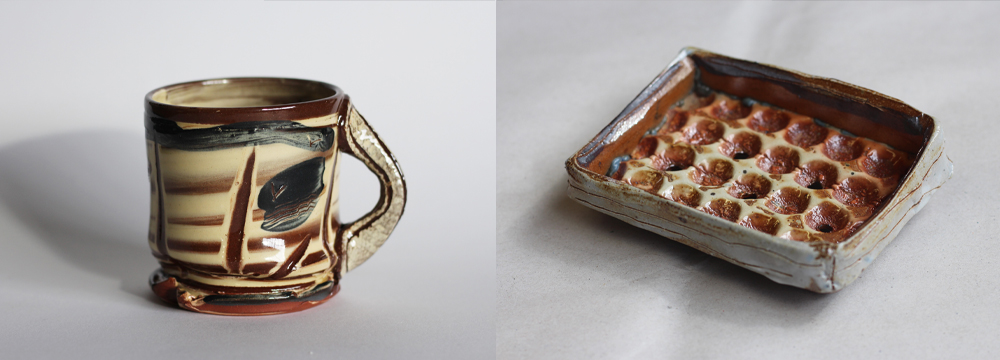 Camille is currently a diploma student at Clay College Stoke. She studied Fine Art at Edinburgh College of Art and was part of the Open School East Associate Programme in 2020-21. She has exhibited at Edinburgh Arts Festival, Folkestone Triennial, Land Art Mongolia Biennial, Turner Contemporary and San Mei Gallery.
Camille is currently a diploma student at Clay College Stoke. She studied Fine Art at Edinburgh College of Art and was part of the Open School East Associate Programme in 2020-21. She has exhibited at Edinburgh Arts Festival, Folkestone Triennial, Land Art Mongolia Biennial, Turner Contemporary and San Mei Gallery. Eve Gnoyke
I am a maker with an interest in form, surface, and the relationship between clay and community. Functionality is at the forefront of my mind when I work, and from there I am process-led in making pots that have a quiet and friendly presence. I’m driven by a desire to make pots for the kitchen that feel good to hold, eat from, and bring joy with use. It’s important to me that domestic context and everyday rituals give purpose to what I make.
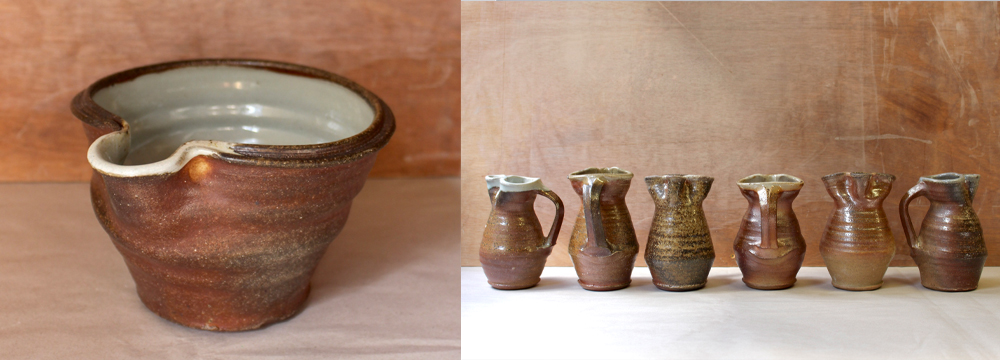 I find inspiration in English medieval forms and the warm-toned surfaces of early European salt-glazed stoneware, as many potters before me have. A more personal source of inspiration that I’ve come to notice is how my hands and mind have responded to living in Stoke, immersed in its history and character. The bones of industry around me and the rich geology beneath me provide a framework to explore what it is that I find to be worthwhile and honest.
I find inspiration in English medieval forms and the warm-toned surfaces of early European salt-glazed stoneware, as many potters before me have. A more personal source of inspiration that I’ve come to notice is how my hands and mind have responded to living in Stoke, immersed in its history and character. The bones of industry around me and the rich geology beneath me provide a framework to explore what it is that I find to be worthwhile and honest.Clay College has been instrumental in providing me with the community, resources, and space to develop my language and confidence in making, and in using locally found materials as a way to ground my work in place and time.
Grazyna Adrian
Motion is what I enjoy in the process of making, and that force is what is in my pots. Splashing on slip and throwing the clay around to make functional, always fun and light pieces to touch and hold and have a lingering look at. Light and dark are big influences on me, especially of the interior and domestic settings, leaching out into the dark of the outside.
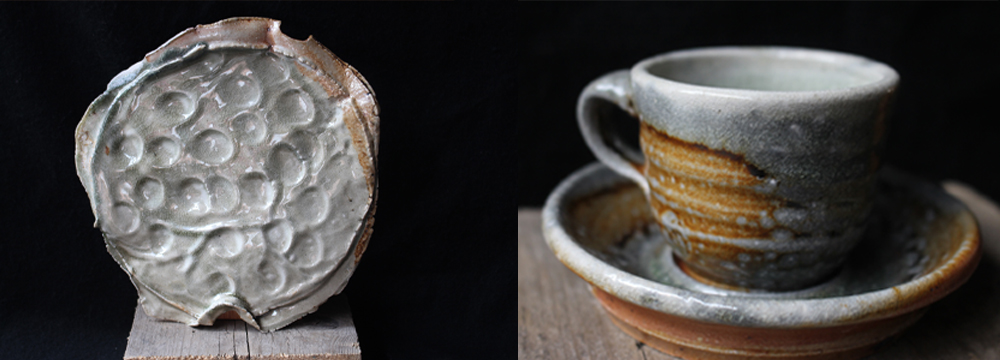 Lamplight, firelight, sunlight through a window, all glancing off the bright and glassy surfaces, while the shadows are absorbed and extended by the dark and matte undersides. These images run around as I slab, and throw and assemble my pots.
Lamplight, firelight, sunlight through a window, all glancing off the bright and glassy surfaces, while the shadows are absorbed and extended by the dark and matte undersides. These images run around as I slab, and throw and assemble my pots. Hannah Sulek
Hannah is a studio potter with a background in textiles and contemporary embroidery. Currently studying at Clay College focusing upon both wheel thrown and handbuilt forms and
firing in a reduction atmosphere. Her work focuses upon surface and mark making, using found materials such as wild clays and ash. She focuses on sourcing natural and non-polluting materials and ingredients for using both in clay bodies and in glazes.
 Her inspiration comes from nature, investigating the intersection between pottery, geology and memory, with the intent to respect and preserve
Her inspiration comes from nature, investigating the intersection between pottery, geology and memory, with the intent to respect and preservemy surroundings. Highlighting the relationship between ceramics and site by studying found materials like clay, rocks and ash.
Lucas George-Jones
From a very young age I had a creative interest in the aesthetic qualities of my surroundings. I always notice details in architecture, nature and form in general. I am drawn to the properties of objects around me not just for their aesthetic look but also how they feel to touch. Texture has always been important to me in my artistic practice, so I count my self lucky to have been introduced to clay as a material at a very young age, I was drawn to it immediately. I have grown to find both the medium of clay and the various processes involved in turning it from mud into a piece of art / pottery fascinating. I make functional everyday items, meant for use with the hope of offering enrichment to those who use them. Food is an important factor when thinking about what the pot may be used for. I am in a very experimental phase in my learning and career and am enjoying exploring the vast roots ceramics has to offer. I am enjoying studying the heritage of studio pottery and there are many makers that I admire and am influenced by. My time spent working with and for other makers has been precious. I hope my body of work speaks for itself and to me as a maker. I think good pots should have a life of their own once fired. I like to make quiet pots that will find a good place in the life of others who appreciate them.
Maya Hughes
I imagine there will be ever going change in my work throughout my life. I’m writing about myself while a shift is underway, not wanting to make any finalised commitments in my words, though I feel I have something to say that is at least valid at this point in time. The fact that I can use materials which I collect in nature from various sentimental locations around me has captured my attention.
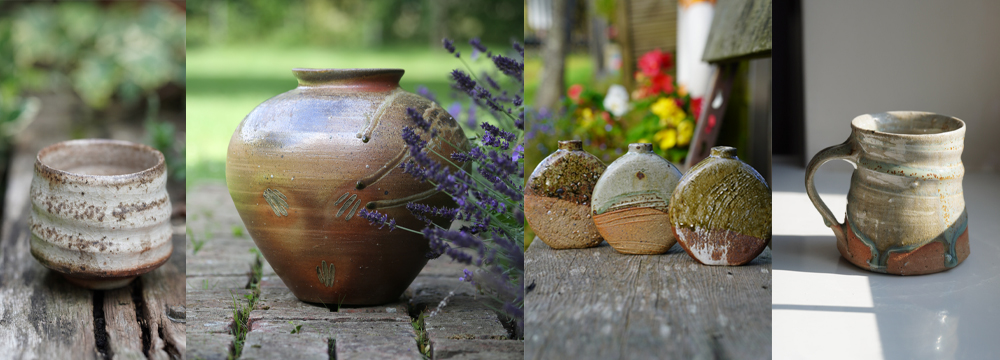 Discovering how to process the materials, use them in my work and be able to yield a good result is astonishing to me. It brings me closer to the piece and I am excited to share with people what it is made from. The relationship between the pot and myself is a two-way street. I am learning to see how I must allow the pot to speak for itself and not over work it. To have as little contact as possible so to keep the piece alive; an entity of its own, with personality.
Discovering how to process the materials, use them in my work and be able to yield a good result is astonishing to me. It brings me closer to the piece and I am excited to share with people what it is made from. The relationship between the pot and myself is a two-way street. I am learning to see how I must allow the pot to speak for itself and not over work it. To have as little contact as possible so to keep the piece alive; an entity of its own, with personality.Millie Brokenbrow
I am interested in how and why people make. I make because it is fuel for my brain to interact with and respond to a material; clay is physical, responsive and interesting. I want to understand the objects we use and create a greater interaction for the user. There is joy in actively contributing to a craft, knowledge can be adapted and tradition conserved by gathering technique and applying it to the making.
Accumulating skills through study and practice keeps me focused on the processes of pottery. Having trained with independent production potteries my skill set began in repetition and pace. Now, in my own practice, I encourage observation to strengthen the subtleties of each pot.
I enjoy making with purpose in mind; simple and functional pots for use in the kitchen. The forms I design and make are practical, comfortable shapes. I bring loose movement into the pots through elegant curves, subtle throwing marks and using slip. I love slip for the character and softness it provides.
Taken together, pattern, marks and movement build to create a greater effect. I see these accumulations everywhere: brick paths, knitted sweaters and tree bark are all built of many and greater for it. I hold this in mind when making. Each technique used highlights the individuality of the others. This collection of marks sit in harmony with each other, and also create a relationship with other pieces.
Rowena Hamilton
I came to pottery after a first career in museums. So, I am influenced by historic pots from Britain and other pottery cultures. I study traditional techniques to help preserve the skills and knowledge of the craft. But in my heart I lean to the DIY attitude of punk and the mash-ups of post-modernism, especially in surface pattern. I believe that things that clash can be beautiful and I’d rather have too much going on than too little.
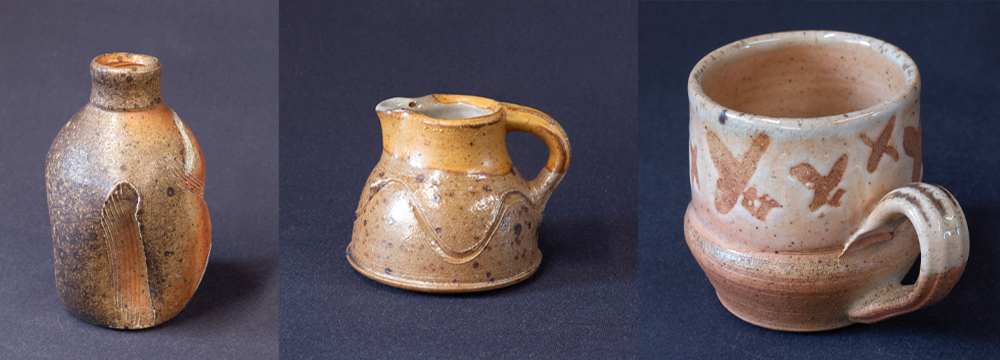 Clay is a responsive medium that can do so much. It records my energetic gestures, allows me to distort and disrupt them, all this within the frame of a functional pot! I love how multi-layered ceramic surfaces are. The pot underneath, the marks on its surface and the glaze over it all. I try to create forms that give me surfaces to decorate but are also pleasing in their shape and comforting to handle. At home I use mine and other potters’ handmade pots every day. Using them makes me notice the materials in them and the energy and skills of their makers. I enjoy the sensory experiences of daily life more as a result and I want to share that with others through my pots. I wish that as a society we bought and used ceramics more selectively. The industry is resource and energy intensive. I see small-scale production of high quality, accessible and useful pottery as a contribution to a slower and more satisfying way of life.
Clay is a responsive medium that can do so much. It records my energetic gestures, allows me to distort and disrupt them, all this within the frame of a functional pot! I love how multi-layered ceramic surfaces are. The pot underneath, the marks on its surface and the glaze over it all. I try to create forms that give me surfaces to decorate but are also pleasing in their shape and comforting to handle. At home I use mine and other potters’ handmade pots every day. Using them makes me notice the materials in them and the energy and skills of their makers. I enjoy the sensory experiences of daily life more as a result and I want to share that with others through my pots. I wish that as a society we bought and used ceramics more selectively. The industry is resource and energy intensive. I see small-scale production of high quality, accessible and useful pottery as a contribution to a slower and more satisfying way of life.Will Keating
Will Keating is a studio potter currently studying at Clay College in Burslem. His pots are intended to be straightforward and uncomplicated additions to the home. Whether functional or sculptural, all of Will's works prioritise found materials such as wood ash, locally dug clays, and recycled glass. His work aims to convey the fundamentally uncontrollable and geological nature of the art of pottery, of the link between potter and earth, telling the user something about the possibility of what lies beneath our feet.
CLAY COLLEGE offers a skills-based, full-time ceramics course taught by potters who make a living through ceramics, something unique in the UK. The Clay College Diploma offers 14 full-time students the opportunity to study intensively for 2 years and to learn from the best of national and international potters. The emphasis is on core skills and the use of materials. Students are taught all aspects of design, throwing, glazing, kiln building and firing, alongside traditional hand building and decoration techniques, augmented by modules focusing on business, selling, publicity and marketing. The Diploma offers students the opportunity to become self-sufficient makers. Alongside the course, we run evening classes, masterclasses, and lectures for the public, giving everyone the opportunity to learn from world-renowned master potters that come to the college to teach.
Clay College Stoke opened its doors on September 11th 2017, with a mission to teach practical pottery skills and design to an international standard and to create highly-skilled, self-sufficient and diverse makers. The college evolved from Adopt a Potter’s apprenticeship scheme, founded by potter Lisa Hammond MBE, to enable ceramic graduates to learn from successful professional potters, the technical and business skills necessary to become self-sufficient potters. Recognising that the focus in Higher Education had shifted from making and practical skills to concept and design, and the threat that this posed to the future of studio pottery, Lisa Hammond and Kevin Millward, a local designer and studio potter with 35 years teaching experience, resolved to set up Clay College to ensure that the skills and practical wisdom of a generation of Master Potters were not lost.






